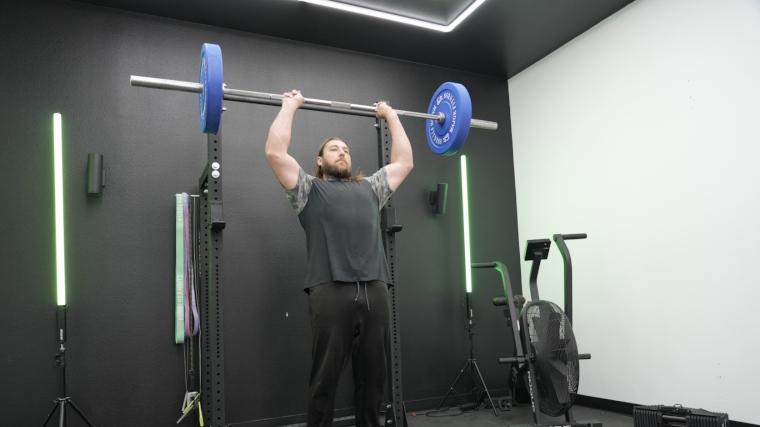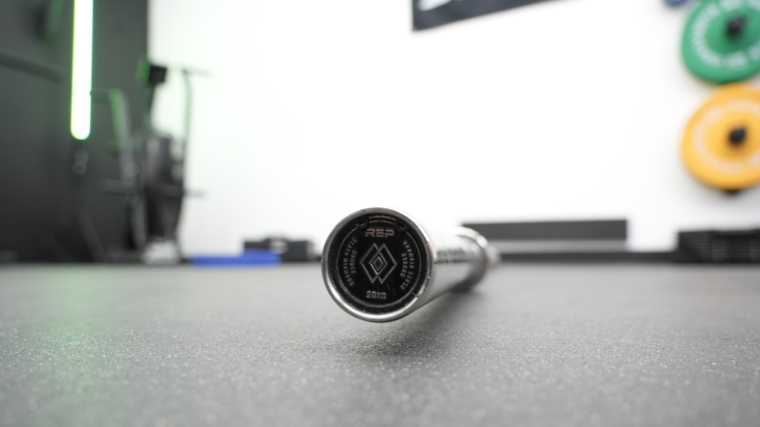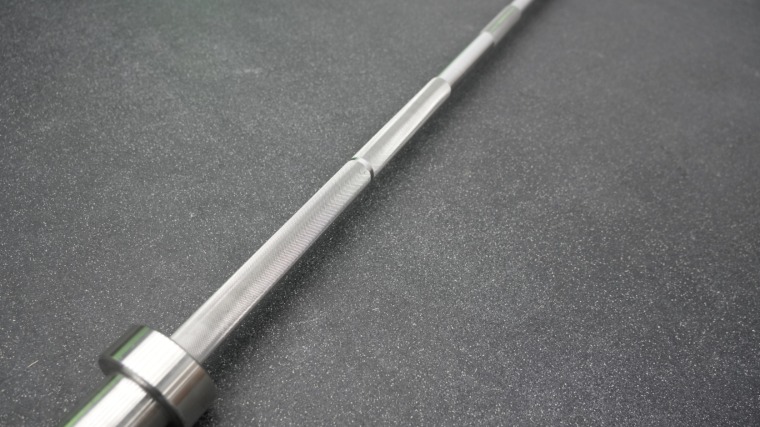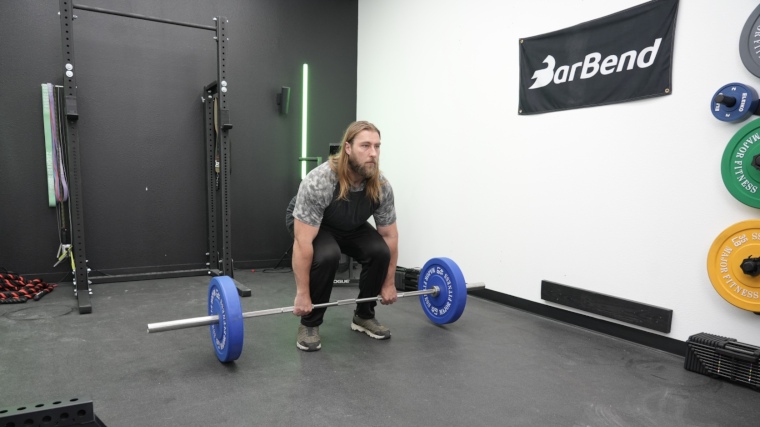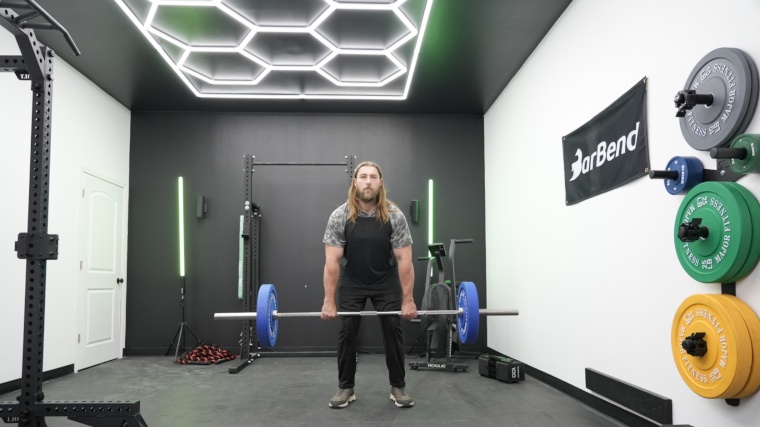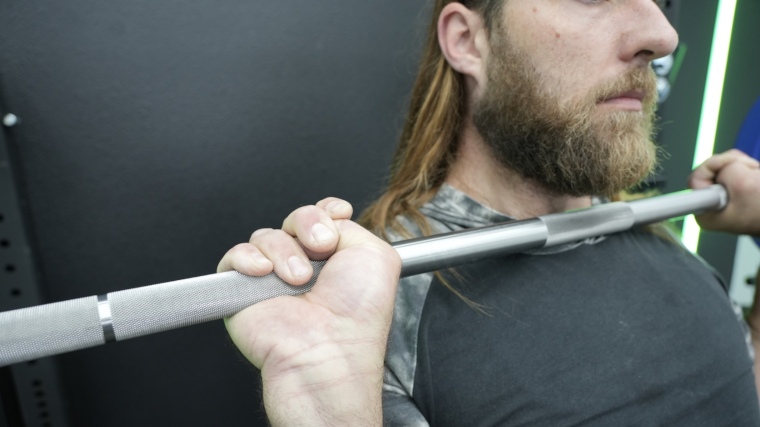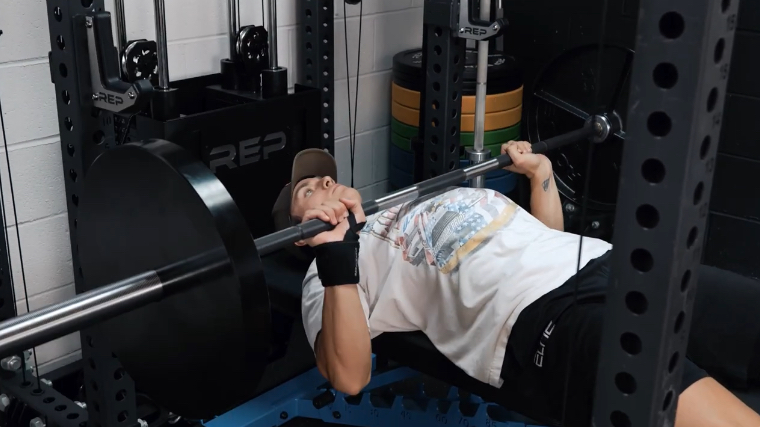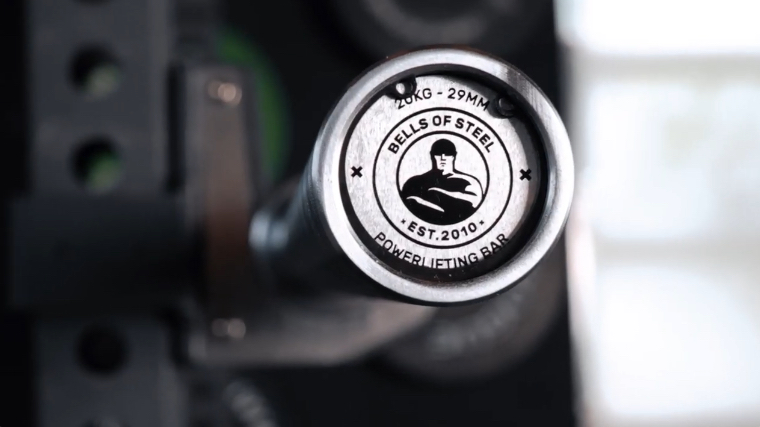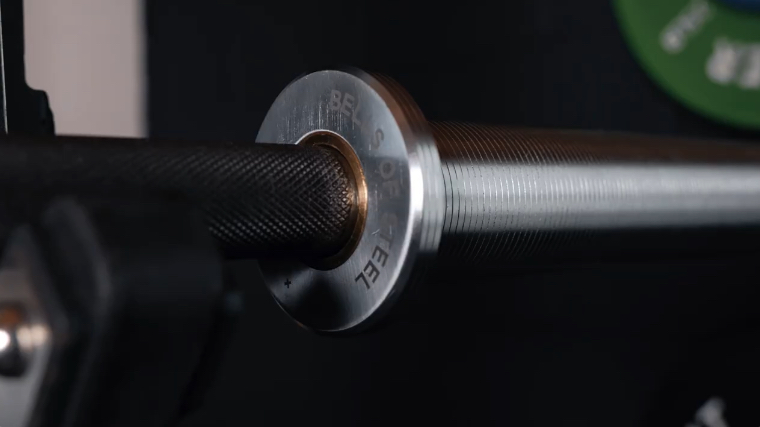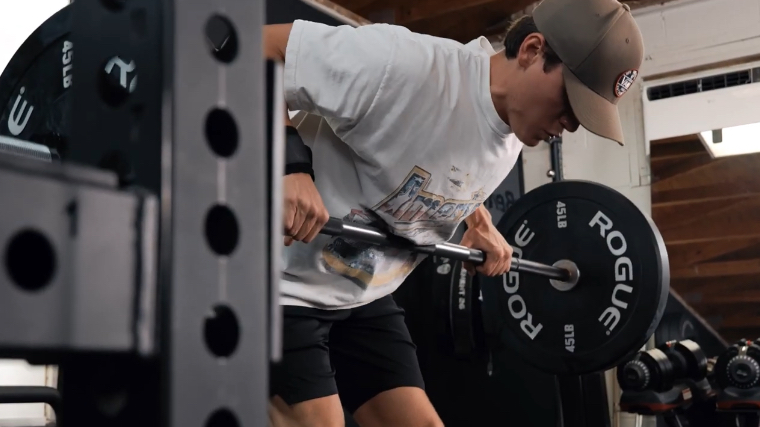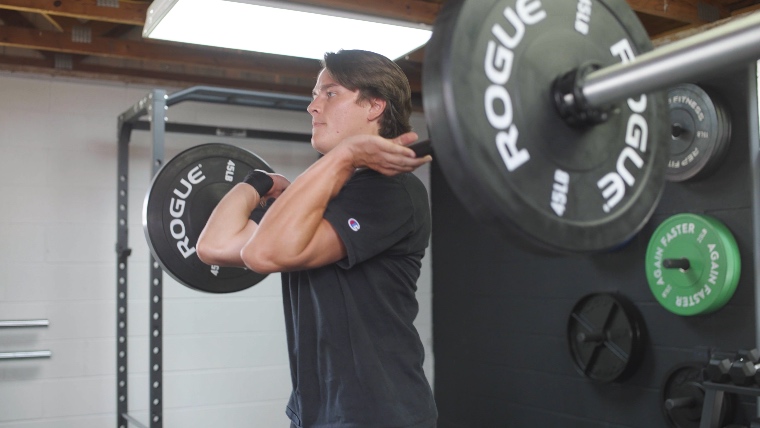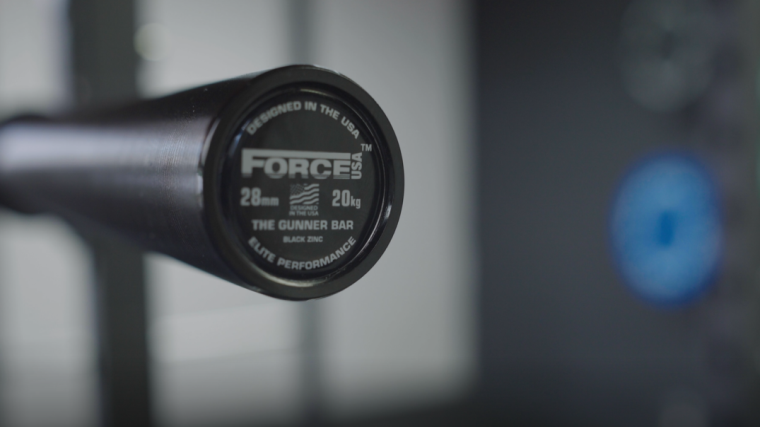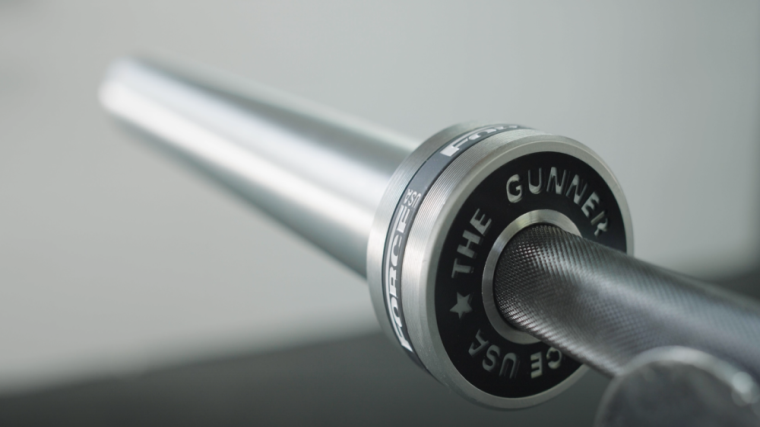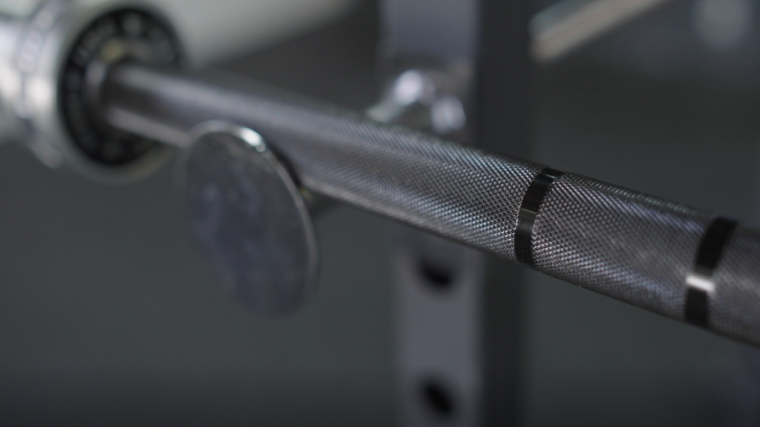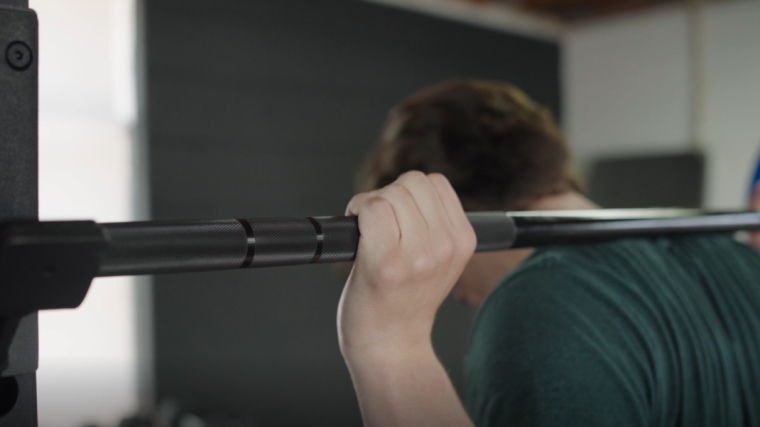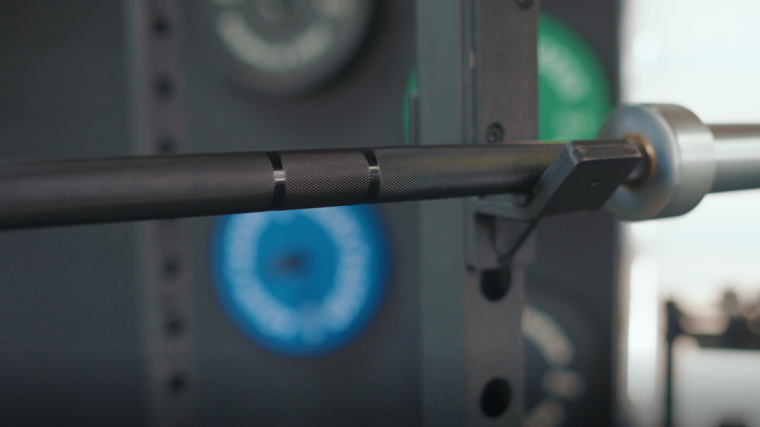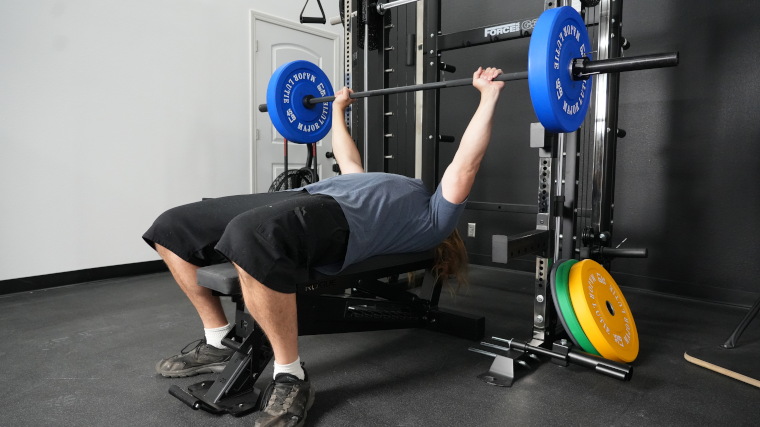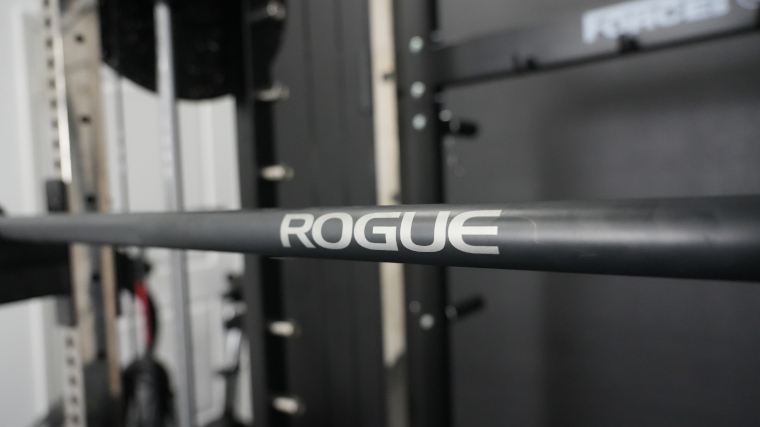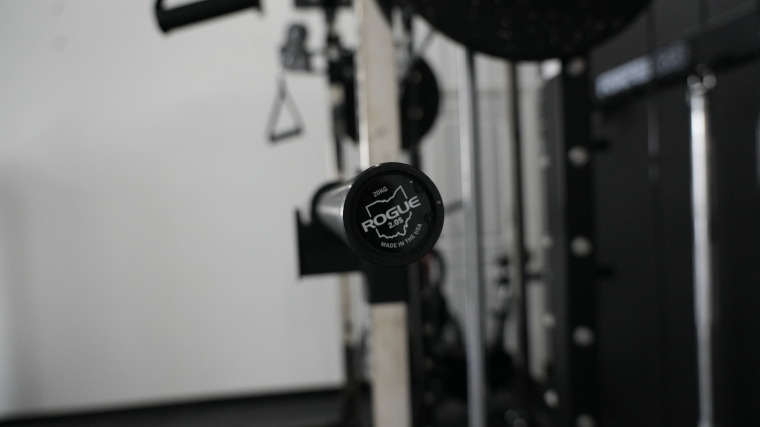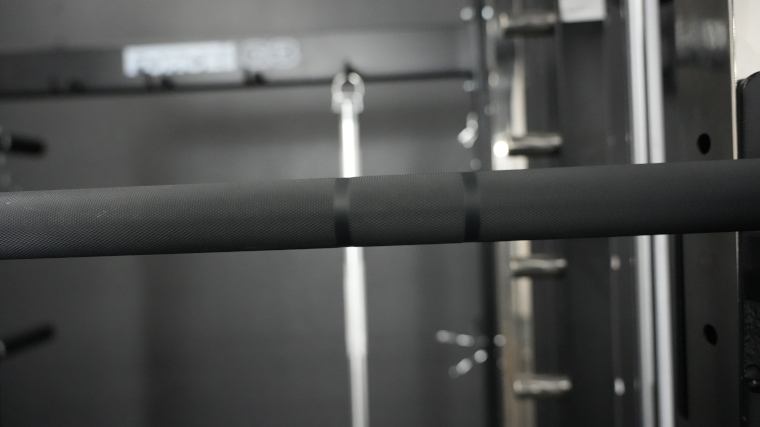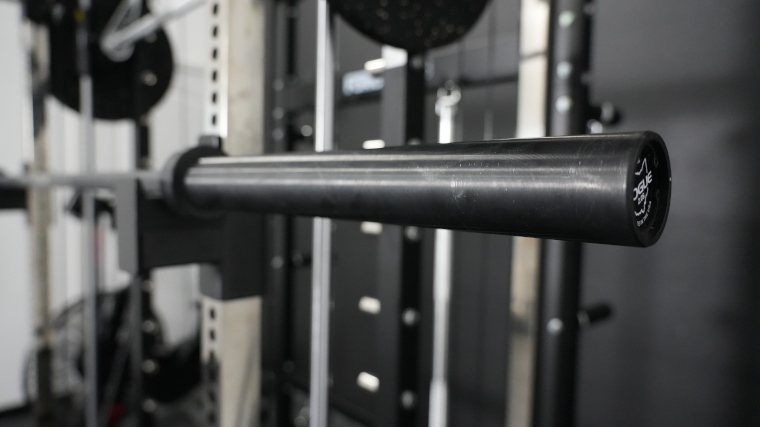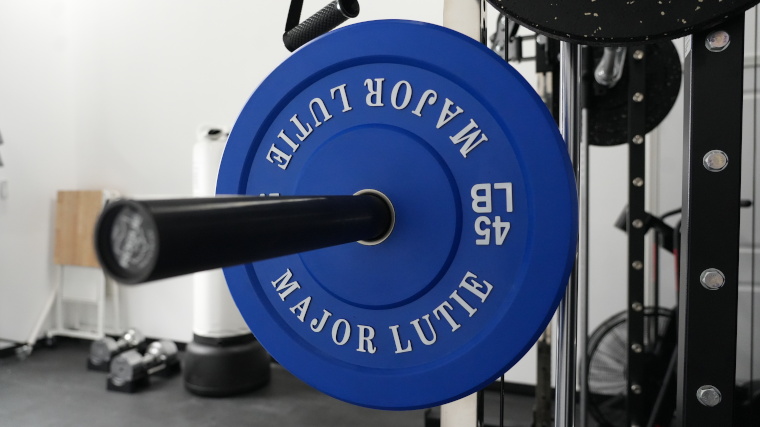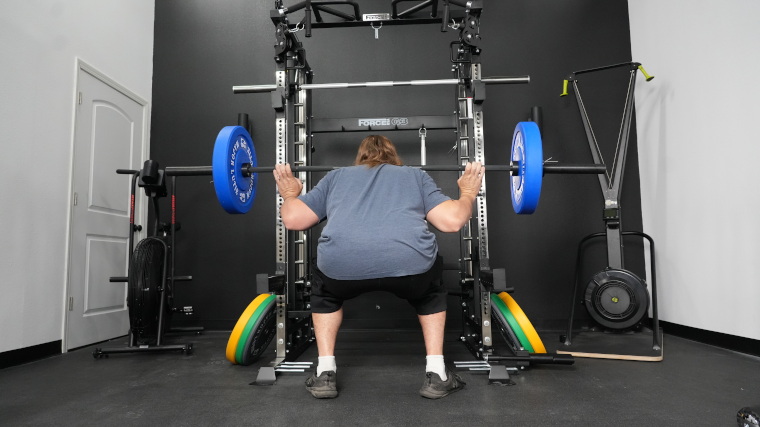Sure, a barbell is a barbell. But also…is it? Yes, you can use any of the best barbells out there to do your basic powerlifting moves — that’s squatting, benching, and deadlifting, of course — but to really make the most out of your training, you’ll want a bar with some differences than the ones you’d find Olympic weightlifting or doing CrossFit. Our team of fitness pros and product testers have put dozens of bars through a battery of tests to find the best powerlifting barbells out there.
As opposed to general-use barbells and Olympic weightlifting barbells, these powerlifting-specific barbells feature more aggressive knurling — including center knurl marks for non-slip back squats — and incredibly high weight ratings and tensile strengths. Here, we’ll take you through all our top choices.
The 6 Best Powerlifting Barbells of 2025
- Best Powerlifting Barbell Overall: REP Fitness Double Black Diamond Power Bar
- Best Budget Powerlifting Barbell: Bells of Steel Barenaked Powerlifting Bar
- Best Powerlifting Barbell for Beginners: Force USA Gunner Barbell
- Best IPF-Approved Powerlifting Barbell: Rogue Ohio Power Bar
- Most Durable Powerlifting Barbell: Fringe Sport Bomba Barbell V3
- Best Powerlifting Barbell for Squats: Vulcan Buffalo Bar
Best Powerlifting Barbell Overall: REP Fitness Double Black Diamond Power Bar
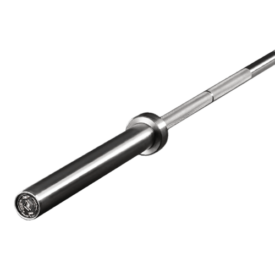
Built for heavy squats, bench presses, and deadlifts, this bar is super stiff for stability with an extra millimeter of thickness to prevent any wobble during high-percentage lifts. Plus, aggressive center knurling prevents the bar from slipping down during low-bar squats.
Specs
- Price: Starts at $299.99
- Weight: 20kg (44.1lbs)
- Tensile Strength: 200,000 PSI
- Weight Rating: 1,500lbs (680kg)
- Diameter: 29mm
- Coatings: Cerakote, stainless steel (shaft); Duracoat, chrome, stainless steel (sleeves)
- Knurling Marks: IPF, deep mountain/aggressive
- Warranty: Limited lifetime
- Bushings/Bearings: Bronze bushings
The REP Fitness Double Black Diamond Power Bar is one of the highest-ranking barbells the BarBend team has tested. Our testers give it powerful (see what I did there?) scores of upwards of 4 out of 5 across almost every category we rank, including a score of 4 out of 5 for construction, 4.5 out of 5 for tensile strength, and 4 out of 5 for rotation system.
Our primary tester, a certified personal trainer, calls this bar a tremendous value and points out that its features make it an excellent choice for powerlifters — all the way from beginner to advanced. “This is one of the best values for a power bar out there,” they explain. “It’s built well and comes with a lifetime warranty against defects, so buyers can feel confident in their purchase.”
But it’s also got a top-notch durability. “The coating options, Cerakote and stainless steel, are some of the most durable choices,” our tester explains. “It’s constructed in a way that makes it easy to slide plates on and off of the sleeves, and the bronze bushings make for a slow but smooth spin, which is ideal for powerlifting.”
Our tester calls out that they have experienced issues with REP’s stainless steel products rusting in the past, and that they’ll keep an eye out for any rust spots forming on this bar. (In the meantime, you might want to familiarize yourself with the best practices for how to clean a barbell.) But so far, after months of using the Black Diamond Power Bar in the stainless finish, so good. We’ll update this review if we experience problems with rust. In the meantime, if you want to avoid more consistent maintenance, the Rogue Ohio Power Bar offers some pretty durable finishings.
Between the lifetime warranty, solid construction, and low price (starting at $299.99), our tester says this is a “can’t miss” barbell, rating the value with a score of 4.5 out of 5 and durability with 5 out of 5.
Read our full REP Fitness Double Black Diamond Power Bar Review.
Best Budget Powerlifting Barbell: Bells of Steel Barenaked Powerlifting Bar
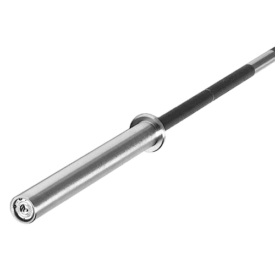
The Bells of Steel Barenaked Powerlifting Bar 2.0 has some of the most aggressive knurling we've seen, so deadlifters won't have to worry about losing grip during heavy pulls. Plus, it has almost no flex, which will appeal to lifters who prefer not to have to pull the slack out before lifting.
Specs
- Price: Starting at $219.99
- Weight: 20kg (44.1lbs)
- Tensile Strength: 210,000 PSI
- Weight Rating: 1,500lbs (680kg)
- Diameter: 29mm
- Coatings: Bare steel, black cerakote
- Knurling Marks: IPF; cheese-grater/medium aggressive
- Warranty: Limited lifetime
- Bushings/Bearings: Bushings and snap rings
Powerlifters on a tight budget can’t go wrong with the Bells of Steel Barenaked Powerlifting Bar 2.0, which we think may be one of the best budget barbells out there for powerlifting. Our product tester Jake Herod calls this barbell one of his favorite power bars and quite possibly the best one at its sub-$230 price point.
“This power bar features a tensile strength rating of 210,000 PSI and a 1,500-pound weight capacity, but it’ll only cost you around $220, which is at least $100 cheaper than some of the top power bars on the market,” Herod explains in his full review of this bar. The reason for the low price is the bare steel shaft, which does make the barbell susceptible to corrosion. But with proper maintenance, it’s very possible to prevent rust — just know that it does take a concerted effort. So, for durability, this version gets itself a mere 3 out of 5 — but we think that’s just fine considering the 5 out of 5 price point.
Do you prioritize low maintenance when you’re considering how to choose a barbell? You’ll be happy to know that Bells of Steel has introduced a new version of the Barenaked Powerlifting Bar in a black Cerakote finish, which increases resistance to corrosion by a landslide. The durable Cerakote finish increases the price to about $270, which is still an arguably unbeatable price for a solid power bar with that relatively eco-friendly coating (and raises that durability score to a 4.5 out of 5).
Among the features that Herod loves is the cheese-grater knurling, which feels less aggressive underneath a layer of Cerakote, earning that version 4.5 out of 5. (It may be too aggressive for beginners on the bare steel version, he notes, dropping to a 4 out of 5 on that bar. If you need less aggressive knurling, we suggest the Fringe Sport Bomba or Force USA Gunner.) With a 29-millimeter diameter and center knurling, it’s built to IPF specifications and is strong enough to easily support the current world-record deadlift with its 1,500-pound static rating.
Read our full Bells of Steel Barenaked Powerlifting Bar 2.0 Review.
Best Powerlifting Barbell for Beginners: Force USA Gunner Barbell
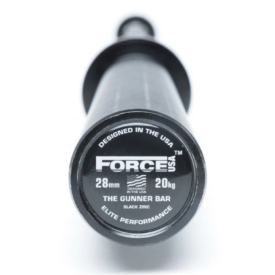
This barbell is available in 20kgs, and is made of 235,000 PSI steel. You can choose between either black zinc or bright zinc sleeves, and either way, this barbell is equipped with smooth stainless steel bearings that offer a great spin.
Specs
- Price: $269
- Weight: 20kg (44.1lbs)
- Tensile Strength: 235,000 PSI
- Weight Rating: 1,500lbs (680kg)
- Diameter: 28mm
- Coatings: Black zinc
- Knurling Marks: Dual (IPF/IWF); no center; medium aggressive
- Warranty: Limited lifetime
- Bushings/Bearings: Dual (stainless steel bushings, 5 needle bearings per sleeve)
This barbell’s impressively high tensile strength of 235,000 PSI is something to brag about. The typical tensile strength range is 150,000 to 210,000 PSI, so the Force USA Gunner is easily one of the strongest barbells we’ve tested. While that makes it an excellent choice for advanced lifters, what makes it great for beginners is its versatility.
The Gunner isn’t a true powerlifting bar nor a true Olympic barbell: It’s multipurpose in nature, with dual IPF and IWF knurl marks. While the lack of center knurling may turn away serious powerlifters, that very factor makes the Gunner an ideal training bar for those interested in trying out different lifting formats — as we suspect many beginners may want to. It gets a 4 out of 5 for versatility, with just a point docked for a lack of center knurling. (If you need center knurling, we suggest any other bar on this list aside from the Fringe Sport Bomba. The Rogue Ohio Power Bar is priced within dollars of the Gunner.)
As product tester Jake Herod writes in his full review of this bar, “It can handle most workouts you throw its way (no matter your fitness level), and you can load up to 1,500 pounds onto it. While the knurling may not be cut deep enough for some powerlifters, you can always add some lifting chalk to help you out. The amount of spin in the sleeves, the lack of a center knurling, and the moderate knurling are what make this bar highly versatile, and a good option for anyone without calluses built up.”
Herod points out that, “The only thing you may have to worry about during your powerlifting sessions is getting a super firm grip since the knurling is not cut very deep. But this is easily solved with some chalk, or gloves.” The knurling gets a 3.5 out of 5 for many powerlifters, but a higher 4.5 out of 5 if you don’t like aggressive knurling.
All in all, the Gunner is a solid all-rounder pick in its price range. Add some of our team’s top picks for the best bumper plates and you’ve got a PR-worthy setup for your home gym.
Read our full Force USA Gunner Barbell Review.
Best IPF-Approved Powerlifting Barbell: Rogue Ohio Power Bar
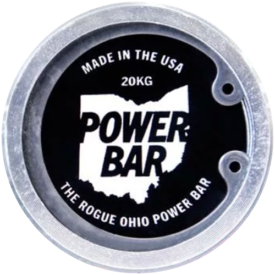
The Rogue Ohio Power Bar is a super stiff and built for heavy loading. A great barbell for powerlifting, the Rogue Ohio Power Bar has "no whip" and aggressive knurling for squats and deadlifts.
Specs
- Price: Starts at $275
- Weight: 45lbs
- Tensile Strength: 205,000 PSI
- Weight Rating: 1,500lbs (680kg)
- Diameter: 29mm
- Coatings: Cerakote, stainless steel, bare steel, E-coat, black zinc (45-lb version); stainless steel, black zinc (20-kg version)
- Knurling Marks: IPF; aggressive
- Warranty: Lifetime
- Bushings/Bearings: Bronze bushings and snap rings
Rogue Fitness is known for making high-quality garage gym equipment, and the Rogue Ohio Power Bar is no exception. In fact, our product tester thinks this is one of the best power bars in general, and — on top of its excellent componentry — loves that it’s American-made.
Before getting into the details, potential buyers should know that only the 20-kilogram version of the OPB is IPF-approved. There is a separate 45-pound version, which does not technically meet IPF specifications — therefore, it is not IPF-approved. Both options are incredibly well-built, durable, and fun to use. However, the 20-kilo version is only available in two finishes (stainless steel and black) as opposed to the 45-pound bar’s five finish options.
The 45-pound Ohio Power Bar starts at $275 for the bare steel version. If you’re not interested in doing the required maintenance to prevent a bare steel bar from rusting, opt for the stainless steel version ($415) or one of the more durable finishes, like Cerakote ($355) or E-coat ($295). The 20-kilogram bar starts at $350 for a black zinc finish and goes for $445 for stainless steel.
Regardless of finish, the knurling is “some of the best in the industry,” according to our product tester. It’s even better than the knurling on the ultra-popular Texas Power Bar, our tester says, which speaks volumes about the grippiness of the Rogue bar.
“The OPB provides an exceptional lifting experience for powerlifting workouts,” our tester says, rating the knurling with 4.75 out of 5 points and the spin with 4.5 out of 5 points. “If you’re looking for a lifetime investment and you never want to buy another power bar, the OPB is the one I recommend.”
[Related: What Is Barbell Knurling?]
Most Durable Powerlifting Barbell: Fringe Sport Bomba Barbell V3
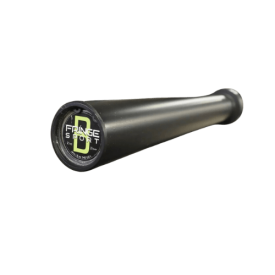
Suited for powerlifting, heavy-duty alloy steel barbell has a tensile strength of 201,000 PSI, moderate whip, and a lifetime warranty.
Specs
- Price: $399
- Weight: 20kg (44.1lbs)
- Tensile Strength: 201,000 PSI
- Weight Rating: Not disclosed
- Diameter: 28mm
- Coatings: Black Cerakote
- Knurling Marks: Dual knurling (double ring IWF and IPF knurling); no center
- Warranty: Lifetime
- Bushings/Bearings: Bearings
With an above-average tensile strength of 201,000 PSI, a static weight rating of 1,500 pounds, and an oxidation-resistant black Cerakote finish, this is one of the most durable barbells our product testers have ever gotten their hands on.
While it’s not exactly a power bar — it features dual IPF and IWF knurl marks, and doesn’t have center knurling — it’s a versatile training tool compatible with all kinds of weight plates and workouts. Between its versatility and durability, we recommend it without hesitation.
For hardcore powerlifters, our tester calls out that the Fringe Sport Bomba bar might spin a bit too freely due to its bearing rotation system. But according to certified personal trainer and BarBend editorial team member Kate Meier, those newer to lifting may not even notice the difference. “Can you bench, squat, or deadlift with a weightlifting bar? Of course,” she says. “And depending on your fitness level, you may not even notice a distinct difference. However, if you compete or lift heavy, you may prefer a bar with limited movement.”
Our product tester rates durability with 4.5 out of 5 points, noting that the black Cerakote finish on the shaft is ideal for corrosion resistance over time. As an added bonus, it’s also a more eco-friendly finish than some other types.
Nodding to the black zinc finish on the sleeves, our tester says, “I personally like black zinc for the sleeves, since it’s durable against metal-to-metal contact. Be aware that it might turn a green-ish color over time, but it’s not a durability issue.” In other words, the sleeves will hold up beautifully colliding with the best weight plates — they just may discolor a little.
As for the knurling, our tester says that advanced lifters with developed calluses might prefer something more aggressive, giving it a 3 out of 5 for those who are seeking a tougher knurling. If that’s you, the REP Fitness Double Black Diamond Power Bar, Vulcan Buffalo Bar, or Rogue Ohio Bar may be more suitable. But for those who plan on using their barbell for weightlifting and general strength training in addition to powerlifting, a more passive knurl isn’t necessarily a bad thing.
Best Powerlifting Barbell for Squats: Vulcan Buffalo Bar

Designed specifically for powerlifting, the Vulcan Buffalo Bar has a curve that can help the lifter position their torso in a way that may help reduce the strain on their chest, back, and biceps. It features a corrosion-resistant black hard chrome coating and can handle a whopping 1,500 pounds.
Specs
- Price: $369.99
- Weight: 47lbs
- Tensile Strength: 190,000 PSI
- Weight Rating: 1,500lbs
- Diameter: 32mm
- Coatings: Black hard chrome shaft and matte hard chrome sleeves
- Knurling Marks: IPF; medium aggressive
- Warranty: Lifetime
- Bushings/Bearings: Bronze bushings
While not as unusual-looking as the best trap bars, the Vulcan Buffalo Bar is a specialty bar in its own right, making for a great squat bar for individuals with shoulder mobility limitations or prior injuries. How? “The curve of this bar really nicely alleviates stress and strain on the muscles of the upper torso, including the chest, shoulders, and upper back,” explains our tester, a certified personal trainer. “It also reduces strain on the biceps, which is super helpful for people with limited arm mobility.”
But it’s not just the helpful shape that makes this bar stand out. During our testing, this bar scores highly for multiple categories, including construction (4 out of 5), coating (4 out of 5), and warranty (5 out of 5), making the Vulcan Buffalo Bar an attractive investment — even if you will be focused on mainly one lift with it.
Since this is a curved bar, it can’t really be used as a deadlift bar, or for a wide range of exercises in general. It’s best suited to exercises that involve positioning the barbell on your upper back/traps. For that reason, this bar scores lower in the versatility category, earning 3 out of 5 points from our tester. It’s possible to do some pressing movements with it, too, but expect a bit of a learning curve as far as hand placement and grip. For a more versatile bar, we recommend the Fringe Sport Bomba or the Force USA Gunner.
One great thing about the Vulcan Buffalo Bar is that it still meets specifications for the expected sleeve length at 16.5 inches. That can sometimes be a problem with specialty bars, so our tester was thrilled to see the normal loadable length. Another feature our tester loves is the black hard chrome finish on the barbell shaft. “While this finish isn’t the most durable to corrosion outright — that would be stainless steel — it offers the best middle ground between oxidation and corrosion from metal-to-metal contact,” they say.
Finally, knurling is something to consider. “This bar has a medium-sharp knurling in my opinion, but it feels different at different places across the bar, because of the process used to manufacture it,” our tester explains. “The bar is knurled, then bent, to achieve the curved shape. This alters the knurling and can be a surprise if you’re not expecting it.” Still, it earns an impressive 4 out of 5 for knurling overall.
All that said, this bar is pretty thick, coming in at 32 millimeters compared to the 28- and 29-millimeter bars on this list. While 29 millimeters is what you need for IPF approval, if you’re just training and have small hands, you may want to opt for the Force USA Gunner or Fringe Sport Bomba, both of which have a more forgiving 28-millimeter diameter.
How We Tested and Chose the Best Powerlifting Bars
Not only does our team have collective decades of experience with dozens upon dozens of barbells, but our testers have also spent years testing powerlifting barbells and rating them according to a multi-point equipment testing methodology on a 1 (fail) to 5 (all green lights) scale. Their backgrounds as athletes, performance coaches, and personal trainers allows them to fairly judge a barbell’s performance in various capacities and understand who a product is best for. Our testers consider several criteria when testing powerlifting barbells:
- Construction: We consider the materials used in creating the barbell, as well as its various components, to determine how well-made the bar is.
- Tensile Strength and Weight Rating: Especially important for powerlifting barbells, we factor tensile strength and weight rating into our overall scores as a measure of the bar’s durability and capability.
- Knurling: We note the aggressiveness of knurling as well as the placement of knurl marks for powerlifting bars to determine what lifts a bar is ideal for.
- Rotation System: We prioritize barbells with durable and long-lasting rotation components; for powerlifting barbells, we look for bushings, which rotate more slowly and are ideal for slower lifts.
- Coating: From Cerakote to zinc, we look for durable coatings that will last a lifetime with proper care and maintenance; we consider the environmental impact of these materials, too.
Benefits of Powerlifting Bars
Anyone interested in lifting weights can benefit from a powerlifting bar, says certified personal trainer and BarBend editorial team member Kate Meier. These are among the most basic types of barbells that are easy for beginners to use, she says, and they have some unique (and intentional) benefits for individuals who like to do the “Big 3” lifts: back squat, bench press, and deadlift.
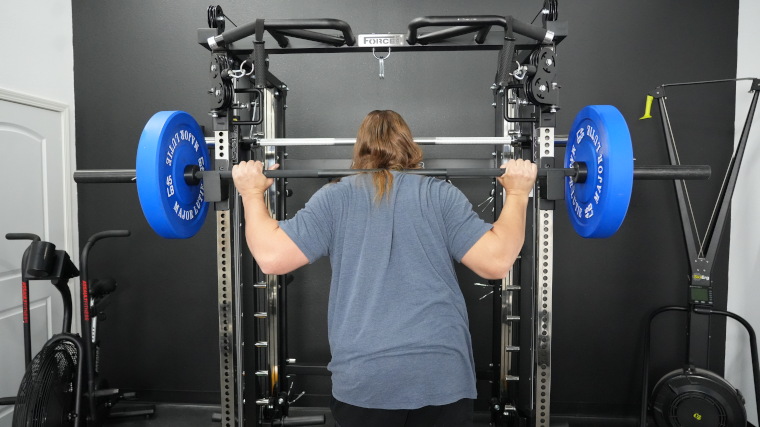
- Knurl Marks: A powerlifting bar has knurling markings on it that identify the widest your hands are permitted to be in competition. Many lifters use those markings to know where to put their hands every time they bench. A power bar also has center knurling, which intends to prevent the bar from slipping when back squatting.
- Aggressive Knurling: Many powerlifting bars are designed with knurling that provides a very secure grip. Some people love this, but if you’re not acclimated to sharp knurling, you may have a bit of a break-in period. Meier recommends using the best lifting chalk to help your hands acclimate.
- Slower Rotation: The stiffness of a powerlifting bar is also key for the squat, bench, and deadlift, because they are slower movements (compared to the Olympic lifts — snatches and clean & jerks). Therefore, you need a bar that won’t spin as readily or as fast.
How Much Do Powerlifting Bars Cost?
Realistically, a good powerlifting barbell costs at least a couple hundred dollars. On the high end, prices can soar to nearly $1,000.
| Best Powerlifting Barbell Overall | REP Fitness Double Black Diamond Power Bar | Starts at $299.99 |
| Best Budget Powerlifting Barbell | Bells of Steel Barenaked Powerlifting Bar | Starts at $219.99 |
| Best Powerlifting Barbell for Beginners | Force USA Gunner Barbell | Starts at $269 |
| Best IPF-Approved Powerlifting Barbell | Rogue Ohio Power Bar | Starts at $275 |
| Most Durable Powerlifting Barbell | Fringe Sport Bomba Barbell V3 | Starts at $399 |
| Best Powerlifting Barbell for Squats | Vulcan Buffalo Bar | Starts at $369.99 |
What to Consider Before Buying a Powerlifting Bar
“First, it should be known that you can squat or deadlift with just about any type of barbell: a dedicated powerlifting bar, a bar designed for Olympic weightlifting, or a cheap Amazon bar,” says Kate Meier, certified personal trainer and BarBend editorial team member. “However, there are significant benefits to using bars designed specifically for powerlifting, which includes squats, benches, and deadlifts.”
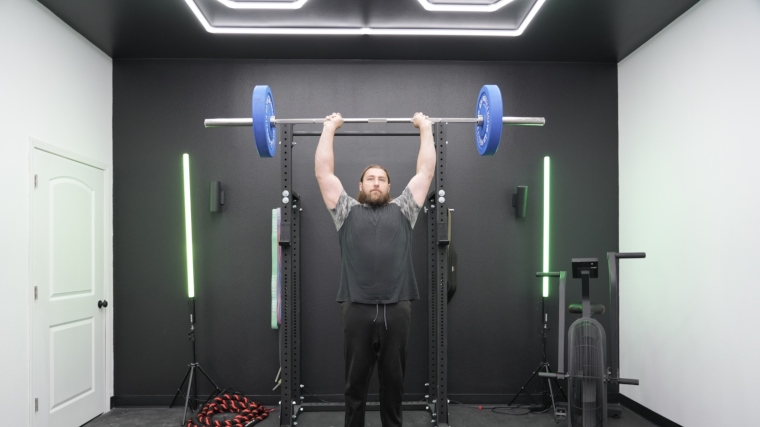
Regardless of whether you’re seeking out the best budget home gym equipment or are searching for top-of-the-line luxury equipment, the criteria you should factor into your search remain the same.
Knurl Marks and Pattern
Presumably, a powerlifting barbell will spend a lot of time in your hands, from deadlifts to the bench press and accessory movements. So, it’s really important that the knurl marks and pattern jive with you. Knurling that’s too passive for you might lead to issues with slippage; knurling that’s too aggressive will hurt your hands and make it hard to lift heavy with the bar (not to mention unpleasant).
IPF Barbell Specifications
A basic powerlifting bar is likely suitable for squats, deadlifts, and bench, explains Meier. But, she recommends taking it one step further and seeking a bar that meets the International Powerlifting Federation’s standards. The IPF standards for a powerlifting bar are:
- Weight: 20 kg
- Grip diameter: 29 mm
- Sleeve diameter: 50 mm
- Length: 2.20 meters
- Markings: Single International Powerlifting Knurl Mark
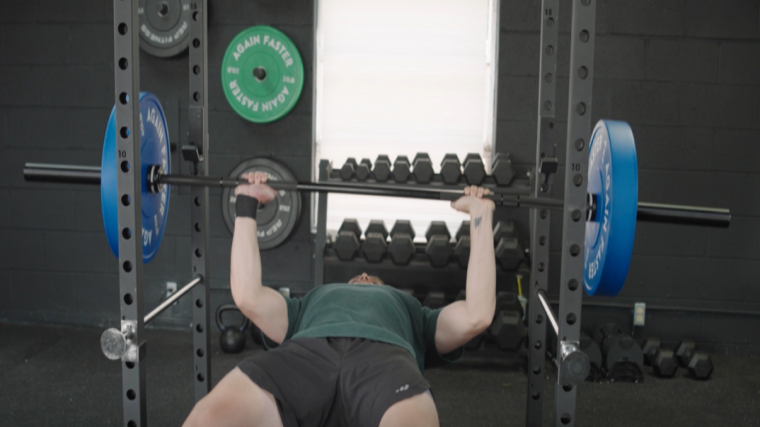
“If you can’t find or afford a bar that is IPF-standard, then pay specific attention to the weight, the grip diameter, and the spin of the bar,” Meier says, noting that the weight should be 20 kilograms, even for women (in Olympic weightlifting, women use a 15-kilogram bar; but most powerlifting federations have competitors of all genders lifting on the same bar).
Shaft Diameter
According to Meier, the diameter of the shaft is key because, especially in the bench press and deadlift, you need to get used to how your hands wrap around the bar. “Lift on a 15-kilogram bar, which usually has a 25-millimeter shaft, and then lift on a 20-kilo bar with a 29-millimeter shaft. You’ll notice a distinct difference in the grip, especially if you have smaller hands,” she says.
Spin
Lastly, the spin very much matters, says Meier. “For powerlifting, you don’t want a bar that spins. A good powerlifting bar is designed to be stiff, providing more stability and predictability through the lifts,” she explains. “This is in contrast to an Olympic weightlifting bar, which has to spin to accommodate the speed and movement of the snatch and clean & jerk.”
[Related: Steps to Nailing Your First Powerlifting Meet]
Powerlifting Bars FAQs
What is the best powerlifting bar?
After using dozens of powerlifting barbells over many years, our product testers determined that the REP Fitness Double Black Diamond Power Bar is the best powerlifting barbell. During testing, it scores at least 4 out of 5 points for all performance categories. Our testers appreciate that it’s built to IPF specifications, spins well but provides necessary stiffness, and features grippy but not overly aggressive knurling.
How much do powerlifting barbells cost?
Powerlifting barbells cost as little as a couple hundred dollars to nearly $1,000. What you pay depends largely on the materials used to create the bar, the machining process, and, of course, the brand. On average, expect to pay between $250 and $500 for a good powerlifting barbell. The best budget powerlifting barbell we’ve found is the Bells of Steel Barenaked Powerlifting Bar, which comes in at $219.99.
What is the difference between a powerlifting bar and a normal bar?
Powerlifting barbells are designed for the sport of powerlifting, which means they have certain features intended to maximize performance on the squat, bench press, and deadlift. These bars tend to have more aggressive knurling to assist with grip, as well as knurl marks in the center of the bar to prevent it from slipping during back squats. They also typically have bushings as opposed to bearings; the former spin more slowly for a more stable lift.
Should powerlifting bars spin?
Powerlifting bars should spin, but minimally compared to weightlifting barbells. Since the power lifts are slower, more stable lifts, there’s no need for the barbell to spin quickly. In fact, less spin makes for more stable power lifts. Looking for barbells with bushings instead of bearings here.
